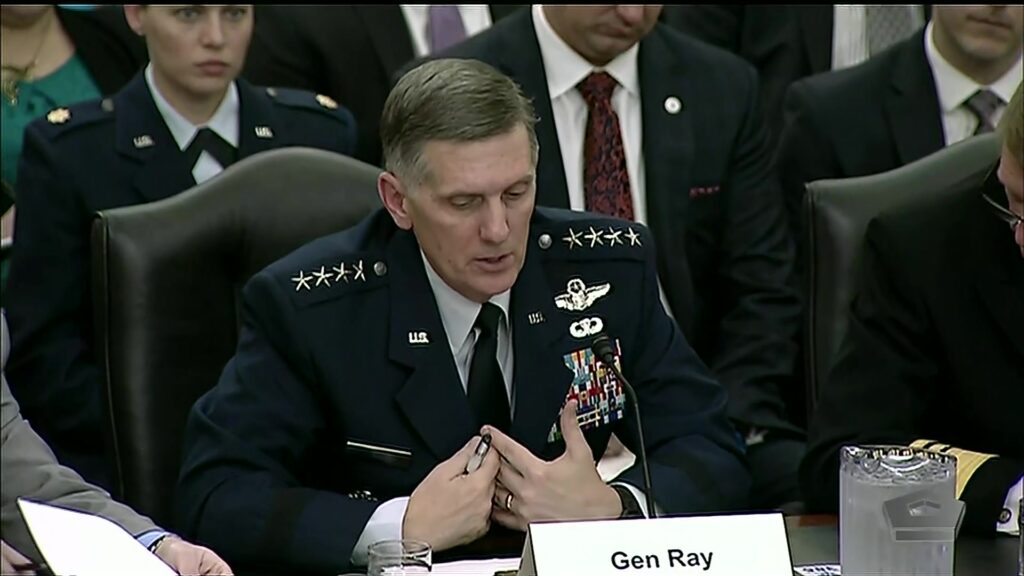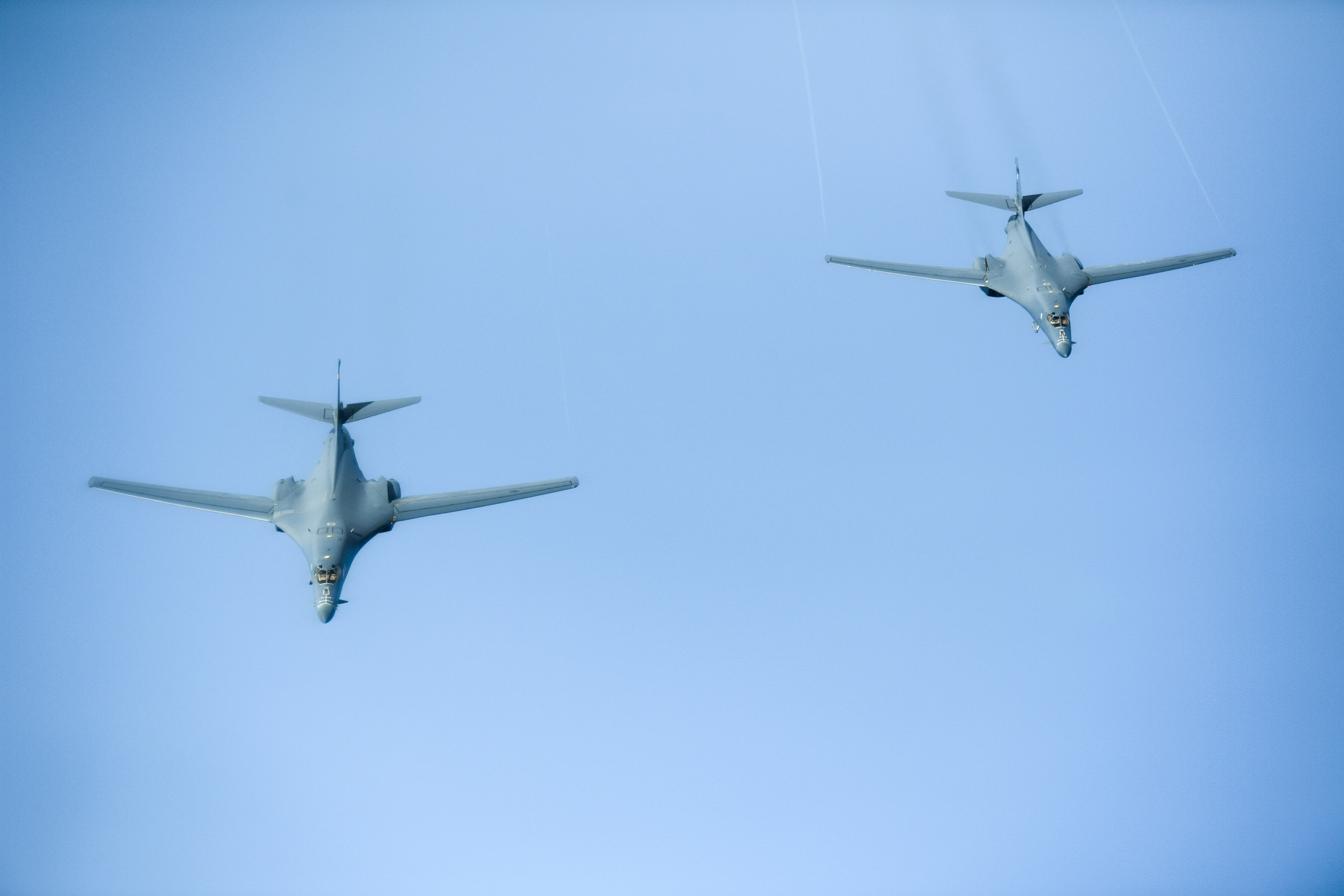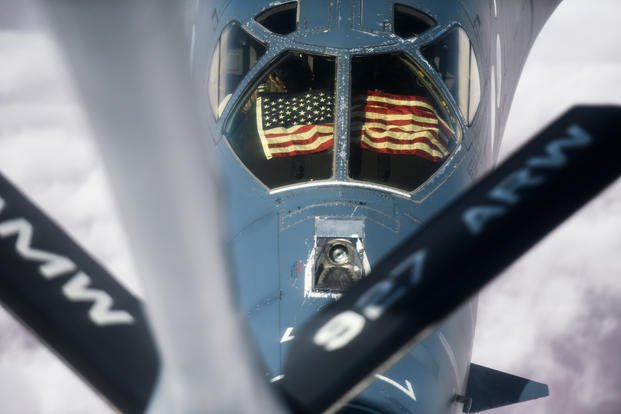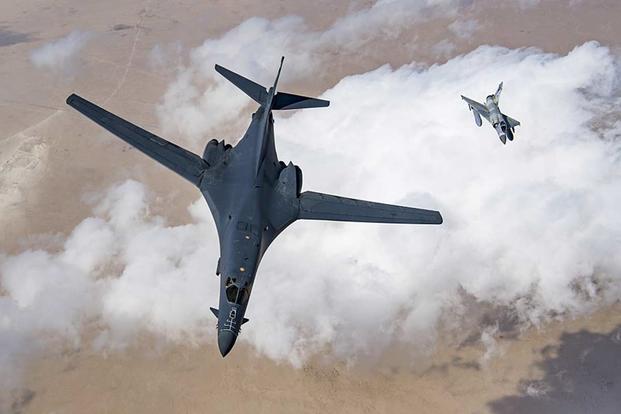- Joined
- 19 July 2016
- Messages
- 3,727
- Reaction score
- 2,693
Looks like they are serious this time, I hope so.
If you expect it to fly "with 4th and 5th Generation fighter", you'll need to have a nearly equal availability rate... Fleet wide.
Otherwise the gamut of missile you promise to provide one day will pale in comparison to the lack of them on overall regarding the number of flight package canceled due to the airframe grounded.
Arsenal is a statistical weapon primarily before any tactical advantages it can bring.
The JimmyCarter B-1B was a compromise of the more maintainable B-1A so the B-1B was obsolete and hard to maintain from its inception.
The B-1B has many great advantages but certainly needs to be replaced and the, smaller than B-2, B-21 is not the answer for payloads
TomcatViP comments stand. The Bone is a hangar honey and needs to be replaced. This NDAA is no where near. A 900B is only a start.If you expect it to fly "with 4th and 5th Generation fighter", you'll need to have a nearly equal availability rate... Fleet wide.
Otherwise the gamut of missile you promise to provide one day will pale in comparison to the lack of them on overall regarding the number of flight package canceled due to the airframe grounded.
Arsenal is a statistical weapon primarily before any tactical advantages it can bring.
It was Ronald Reagan's B-1B. Carter cancelled the B-1 in favor of cruise missiles on B-52s and the B-2 (which he found out about when he took office).The JimmyCarter B-1B was a compromise of the more maintainable B-1A so the B-1B was obsolete and hard to maintain from its inception. The B-1B has many great advantages but certainly needs to be replaced and the, smaller than B-2, B-21 is not the answer for payloads required. Smaller and smaller munitions are great but do not obviate the needs that only a large payload craft similar to B-1 can meet.
LM's proposed H-Bomber would be good start, it should be manned vs what LM proposed as Unmanned as it still needs to carry and fulfill Bone missions which include CAS. Some of the resource spent on too many Hyper projects could be spent on a manned multi-mission bomber/launcher.
1). not sure how one knows that this is not a LM version but ok.LM's proposed H-Bomber would be good start, it should be manned vs what LM proposed as Unmanned as it still needs to carry and fulfill Bone missions which include CAS. Some of the resource spent on too many Hyper projects could be spent on a manned multi-mission bomber/launcher.
Ok, you really have to be deliberately trying to be this wrong.
1) That's not a Lockheed Martin proposal for anything. It's somebody's faked up concept art for the Russian PAK DA. I'm sure LM has some hypersonic bomber art but this isn't it.
2) Hypersonic strike and loitering CAS are two roles that cannot possibly be accommodated in one airframe. An airframe that can manage Mach 4+ cannot efficiently loiter for hours at subsonic speeds. It's not physically possible within shouting distance of the current state of the art.
3) USAF is developing a manned multi-mission bomber. It's called the B-21. That's all the money there is. Killing all of the hypersonic missile programs in total wouldn't fund another manned bomber program of any sort, much less your hypersonic loitering fiction.
So many compromises were made from the original higher speed design which Carter cancelled the Bone was not able to be contructed properly and thus many of the maintainence problems it suffers from today. So standing the mess started not w/ Reagan.It was Ronald Reagan's B-1B. Carter cancelled the B-1 in favor of cruise missiles on B-52s and the B-2 (which he found out about when he took office).The JimmyCarter B-1B was a compromise of the more maintainable B-1A so the B-1B was obsolete and hard to maintain from its inception. The B-1B has many great advantages but certainly needs to be replaced and the, smaller than B-2, B-21 is not the answer for payloads required. Smaller and smaller munitions are great but do not obviate the needs that only a large payload craft similar to B-1 can meet.

TomcatViP comments stand. The Bone is a hangar honey and needs to be replaced. This NDAA is no where near. A 900B is only a start.If you expect it to fly "with 4th and 5th Generation fighter", you'll need to have a nearly equal availability rate... Fleet wide.
Otherwise the gamut of missile you promise to provide one day will pale in comparison to the lack of them on overall regarding the number of flight package canceled due to the airframe grounded.
Arsenal is a statistical weapon primarily before any tactical advantages it can bring.
LM's proposed H-Bomber would be good start, it should be manned vs what LM proposed as Unmanned as it still needs to carry and fulfill Bone missions which include CAS. Some of the resource spent on too many Hyper projects could be spent on a manned multi-mission bomber/launcher.
TomViP and I were never refering to your posting so not sure what your talking about. Referbishing is great and political climate is not a scientific one.TomcatViP comments stand. The Bone is a hangar honey and needs to be replaced. This NDAA is no where near. A 900B is only a start.If you expect it to fly "with 4th and 5th Generation fighter", you'll need to have a nearly equal availability rate... Fleet wide.
Otherwise the gamut of missile you promise to provide one day will pale in comparison to the lack of them on overall regarding the number of flight package canceled due to the airframe grounded.
Arsenal is a statistical weapon primarily before any tactical advantages it can bring.
Apparently you don't know how maintenance works. When you don't perform it, it doesn't happen. When you do, it does. Go back and read the article in the first post.

There remains an argument whether bombers should even be part of any Nuclear response. A bomer needs for sure to contribute to conventional peer to peer and B-21 is not that answer as it carries too little.Irrespective of structural or other issues with the B-1B it makes up the bulk of the conventional strike fleet. By 2030 the newest will have been in service for 40 years. How many 40 year old airliners are flying in revenue service today? No shame if it's retired once it's capability is migrated to a different platform in my opinion.
General Ray who commands the Global Strike Command has asked Asst. Sec. Will Roper for a low cost stand-off bomb truck. This may end up being the B-1B replacement:

Ray Asks Roper To Explore 'Bomb Truck' For Cheap Standoff Capability - Breaking Defense
"There is no significant game plan here," Ray said about the idea of a 'bomb truck.' "I just think, why not? You can't win if you don't play."breakingdefense.com
As for the difference in payload between the B-2 and the B-21 how may nuclear strikes can a bomber realistically make before the crew and or airframe are in-operable? Can you deliver 16 nukes to 16 aim points and survive without running out of fuel, damage from near misses or incapacitating the crew from radiation exposure? I would think range is more important than payload in nuclear strikes.
The bottom line however is the price of admission to the Super Power club. Folks grouse over the costs of maintaining the military aircraft fleets and weapons but if you want to be a super power you need to pony up. Maintaining 67 B-52H's, 66 B-1B's and 20 B-2A's is the price of admission either we're in the game or we are not.
TomViP and I were never refering to your posting so not sure what your talking about.TomcatViP comments stand. The Bone is a hangar honey and needs to be replaced. This NDAA is no where near. A 900B is only a start.If you expect it to fly "with 4th and 5th Generation fighter", you'll need to have a nearly equal availability rate... Fleet wide.
Otherwise the gamut of missile you promise to provide one day will pale in comparison to the lack of them on overall regarding the number of flight package canceled due to the airframe grounded.
Arsenal is a statistical weapon primarily before any tactical advantages it can bring.
Apparently you don't know how maintenance works. When you don't perform it, it doesn't happen. When you do, it does. Go back and read the article in the first post.
One can argue whether oxygen is necessary for humans too. Not successfully mind you but you can argue it.There remains an argument whether bombers should even be part of any Nuclear response. A bomer needs for sure to contribute to conventional peer to peer and B-21 is not that answer as it carries too little.
There remains an argument whether bombers should even be part of any Nuclear response. A bomer needs for sure to contribute to conventional peer to peer and B-21 is not that answer as it carries too little.Irrespective of structural or other issues with the B-1B it makes up the bulk of the conventional strike fleet. By 2030 the newest will have been in service for 40 years. How many 40 year old airliners are flying in revenue service today? No shame if it's retired once it's capability is migrated to a different platform in my opinion.
General Ray who commands the Global Strike Command has asked Asst. Sec. Will Roper for a low cost stand-off bomb truck. This may end up being the B-1B replacement:

Ray Asks Roper To Explore 'Bomb Truck' For Cheap Standoff Capability - Breaking Defense
"There is no significant game plan here," Ray said about the idea of a 'bomb truck.' "I just think, why not? You can't win if you don't play."breakingdefense.com
As for the difference in payload between the B-2 and the B-21 how may nuclear strikes can a bomber realistically make before the crew and or airframe are in-operable? Can you deliver 16 nukes to 16 aim points and survive without running out of fuel, damage from near misses or incapacitating the crew from radiation exposure? I would think range is more important than payload in nuclear strikes.
The bottom line however is the price of admission to the Super Power club. Folks grouse over the costs of maintaining the military aircraft fleets and weapons but if you want to be a super power you need to pony up. Maintaining 67 B-52H's, 66 B-1B's and 20 B-2A's is the price of admission either we're in the game or we are not.

Very quickly, I'd imagine.How would one loiter with a hypersonic aircraft?
All the more need for hypersonic B-1 replacement not a slow BWB.
Senator: About 10 Percent of B-1s are Fully Combat-Ready | Air & Space Forces Magazine
A B-1 assigned to the 37th Bomb Squadron takes off from Ellsworth AFB, S.D., on Oct. 24, 2018. Air Force photo by SrA. Denise Jenson. Only six of the Air Force’s 61 B-1 bombers are fully mission-capable, a South Dakota...www.airforcemag.com



Aging B-1 Bomber May Soon Have to Restrict the Way it Flies
The B-1B Lancer bomber, a plane designed with the ability to fly fast and low to the Earth in order to avoid enemy radars, might find itself operating at higher altitudes for the rest of its days.www.military.com

With B-1 Aging and B-21 Still Years Out, Air Force May Soon Have No Go-To Bomber
The U.S. is the only allied country that still flies bombers.www.military.com
"boneyard"
This conclusion would hint that Rockwell should never have been in the jet bomber business (an explaination of why they are not now) and the B-1 and its derivatives maybe should not ever been in service. Too many compromises like the Space Shuttle. Design by bad budgets and committees.With regards to the B1b speed limitation I understand the following;-
The intake spill vents are oriented such that they vented across the wing lower surface. Therefore in the event of a supersonic engine unstart (surge) the aircraft would yaw, due to the asymmetric loss of thrust, and roll into the yaw due to a loss of lift as a result the excess air venting from the spill doors impinging on lower wing surface. The aircraft was judged to be unrecoverable above approx 1.2 Mach and the probability of a supersonic unstart was unacceptable to the safety case.
This information came from a very nervous FAA test pilot who had to demonstrate supersonic unstarts as part of Concorde certification. Concorde’s intake spill vents operate downward, thus hence no loss of lift meaning supersonic unstarts were completely benign(safe) during any part of its flight envelope.
The technical lead for Concorde intake design, Dr Talbot, participated in consultancy to Rockwell in the mid/late seventies, where he was told the B1a’s total flight test time at 2.0 Mach was less than ten hours due the above concerns.
" It's no longer a question of if, but when the Air Force and Congress will send the aircraft to the Boneyard. "
Second, the B-21’s payload is perfect for it’s mission it doesn’t need to carry more.
Except B-52. It will be ethernal..." It's no longer a question of if, but when the Air Force and Congress will send the aircraft to the Boneyard. "
The same could be said of every aircraft in the inventory.
Regarding the top speed, the plan as I remember it was that production B-1As would retain the variable intakes, but they would be deactivated in normal operations. This would save a significant amount on maintenance, and if it was later determined that on certain missions the capability would be needed, they would be activated. I don't know if activation involved just pushing in certain circuit breakers and telling the FCS the intakes were back or whether external actions had to be taken on the flight line. The Navy followed the exact same stratagem on the F-14D. The variable ramps were there, but deactivated.
You know Rockwell equals North American Aviation, right? Not an organisation exactly unfamiliar with jet bombers and fighters.This conclusion would hint that Rockwell should never have been in the jet bomber business (an explaination of why they are not now) and the B-1 and its derivatives maybe should not ever been in service. Too many compromises like the Space Shuttle. Design by bad budgets and committees.With regards to the B1b speed limitation I understand the following;-
The intake spill vents are oriented such that they vented across the wing lower surface. Therefore in the event of a supersonic engine unstart (surge) the aircraft would yaw, due to the asymmetric loss of thrust, and roll into the yaw due to a loss of lift as a result the excess air venting from the spill doors impinging on lower wing surface. The aircraft was judged to be unrecoverable above approx 1.2 Mach and the probability of a supersonic unstart was unacceptable to the safety case.
This information came from a very nervous FAA test pilot who had to demonstrate supersonic unstarts as part of Concorde certification. Concorde’s intake spill vents operate downward, thus hence no loss of lift meaning supersonic unstarts were completely benign(safe) during any part of its flight envelope.
The technical lead for Concorde intake design, Dr Talbot, participated in consultancy to Rockwell in the mid/late seventies, where he was told the B1a’s total flight test time at 2.0 Mach was less than ten hours due the above concerns.
As stated a combined cycle allows hyper and conventional jet operation.Here is the latest on the B-1B

Improved B-1 Readiness Showcased in Short-Notice Middle East Deployment | Air & Space Forces Magazine
USAF's B-1 fleet health has improved, enabling the head of Air Force Global Strike Command to send the bombers on a short-notice Middle East deployment.www.airforcemag.com
How would one loiter with a hypersonic aircraft?
